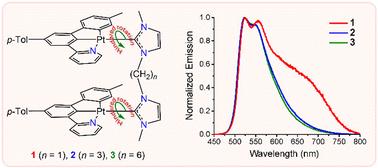具有桥接二- nhc和N^C^C配体的双金属铂(II)配合物:合成和光物理性质
IF 3.3
3区 化学
Q2 CHEMISTRY, INORGANIC & NUCLEAR
引用次数: 0
摘要
本文合成了三种新型双金属Pt(II)化合物[{Pt(dmtppy)}2{μ-(ImMe)2(CH2)n}] [n = 1(1), 3(2), 6(3)],其中dmtppy为二金属化三齿体n ^C^C配体2-(4,4 " -二甲基-[1,1 ':3 ',1 " -三苯基]-5 ' -基)吡啶,ImMe为n -甲基咪唑- n -基-2-基-吡啶],以探索它们形成影响其发光的分子组合的能力。围绕Pt-carbene键的受限旋转导致了atropisomers的混合物,这阻碍了单晶的生长。在298 K (PLQY: 73-77%)下,该配合物在掺量为2 wt%的PMMA薄膜中显示出高磷光量子产率的高效发射。随着溶剂的变化,它们在流体溶液中的光物理性质发生了显著的变化,在2-甲基四氢呋喃中发现的效率最高(络合物3的量子产率高达63%)。对于含有最短键的配合物1,在MeCN和MeOH中形成准分子会导致发射明显猝灭,量子产率大幅下降。本文章由计算机程序翻译,如有差异,请以英文原文为准。

Bimetallic platinum(II) complexes with bridging di-NHC and N^C^C ligands: synthesis and photophysical properties
Three new bimetallic Pt(II) compounds of the type [{Pt(dmtppy)}2{μ-(ImMe)2(CH2)n}] [n = 1 (1), 3 (2), 6 (3)], where dmtppy is the dimetalated tridentate N^C^C ligand 2-(4,4′′-dimethyl-[1,1′:3′,1′′-terphenyl]-5′-yl)pyridine and ImMe is N-methylimidazol-N-yl-2-ylidene, have been synthesized in order to explore their ability to form molecular assemblies that affect their luminescence. Restricted rotation around the Pt–carbene bond leads to mixtures of atropisomers, which hinder the growth of single crystals. The complexes show efficient emissions with high phosphorescence quantum yields in 2 wt% doped PMMA films at 298 K (PLQY: 73–77%). Significant modifications of their photophysical properties in fluid solution are observed upon variation of the solvent, with the highest efficiencies found in 2-methyltetrahydrofurane (up to 63% quantum yield for complex 3). In the case of complex 1, which contains the shortest linkage, the formation of excimers in MeCN and MeOH causes a significant quenching of the emission, with a substantial decrease in the quantum yield.
求助全文
通过发布文献求助,成功后即可免费获取论文全文。
去求助
来源期刊

Dalton Transactions
化学-无机化学与核化学
CiteScore
6.60
自引率
7.50%
发文量
1832
审稿时长
1.5 months
期刊介绍:
Dalton Transactions is a journal for all areas of inorganic chemistry, which encompasses the organometallic, bioinorganic and materials chemistry of the elements, with applications including synthesis, catalysis, energy conversion/storage, electrical devices and medicine. Dalton Transactions welcomes high-quality, original submissions in all of these areas and more, where the advancement of knowledge in inorganic chemistry is significant.
 求助内容:
求助内容: 应助结果提醒方式:
应助结果提醒方式:


